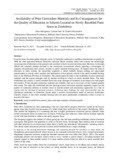Please use this identifier to cite or link to this item:
https://cris.library.msu.ac.zw//handle/11408/1563Full metadata record
| DC Field | Value | Language |
|---|---|---|
| dc.contributor.author | Mangwaya, Ezron | - |
| dc.contributor.author | Jeko, Ishmael | - |
| dc.contributor.author | Manyumwa, Canisius | - |
| dc.date.accessioned | 2016-06-13T09:45:06Z | - |
| dc.date.available | 2016-06-13T09:45:06Z | - |
| dc.date.issued | 2013 | - |
| dc.identifier.issn | 1911-2017 | - |
| dc.identifier.uri | http://dx.doi.org.access.msu.ac.zw:2048/10.5539/ass.v9n1p249 | - |
| dc.identifier.uri | http://hdl.handle.net/11408/1563 | - |
| dc.description.abstract | In recent times the entire public education sector in Zimbabwe underwent a significant deterioration in quality. In 2009 the state appointed National Education Advisory Board similarly noted with concern the increasingly worsening state of education in the primary and secondary schools in rural and urban areas. However, worryingly, official and scholarly attention focused on the mainstream conventional schools, ignoring a sub-category of uniquely circumstanced rural schools, located on newly resettled farming areas. To inquire about the state of education in these schools, the researchers employed a mixed methods design, sending out open-ended questionnaires to twenty school teachers and headmasters at four primary schools in the newly resettled farming areas in the Midlands Province of Zimbabwe. The questionnaire focused on the availability of print curriculum materials and the coping strategies used by teachers working in schools on newly resettled farms. The study established that schools on newly resettled farms face acute shortages of textbooks in all subjects for both pupils and teachers. Where the print curriculum materials are available, they are in most cases of very limited quantity and variety. The study also established that this shortage of print curriculum materials negatively impacts on the quality of curriculum delivery as teachers resort to teacher-centred and transmissive approaches as a way of coping with the shortage of learning resources. Following these findings, the study recommended that the educational authorities in Zimbabwe should adopt a positive discrimination model of resource distribution whereby schools in the newly resettled farming areas are given preferential consideration when it comes to resource allocation. | en_US |
| dc.language.iso | en | en_US |
| dc.publisher | Canadian Center of Science and Education | en_US |
| dc.relation.ispartofseries | Asian Social Science;Vol. 9, No. 1; p. | - |
| dc.subject | Newly resettled farm schools, print curriculum materials, education quality | en_US |
| dc.title | Availability of print curriculum materials and its consequences for the quality of education in schools located on newly resettled farm areas in Zimbabwe | en_US |
| dc.type | Article | en_US |
| item.openairecristype | http://purl.org/coar/resource_type/c_18cf | - |
| item.fulltext | With Fulltext | - |
| item.grantfulltext | open | - |
| item.openairetype | Article | - |
| item.cerifentitytype | Publications | - |
| item.languageiso639-1 | en | - |
| Appears in Collections: | Research Papers | |
Files in This Item:
| File | Description | Size | Format | |
|---|---|---|---|---|
| Availability of print curriculum materials.pdf | Full Text | 160.55 kB | Adobe PDF |  View/Open |
Page view(s)
100
checked on Apr 18, 2025
Download(s)
20
checked on Apr 18, 2025
Google ScholarTM
Check
Items in MSUIR are protected by copyright, with all rights reserved, unless otherwise indicated.



